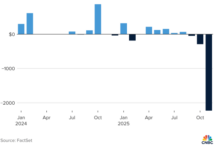The world in 2024 continues to witness complex and unpredictable dynamics, fraught with risks and instability. Strategic competition among major powers intensifies, while geopolitical tensions and military conflicts in certain regions impact global peace and stability, disrupting trade, investment, production, and consumption patterns. However, the global economic growth outlook remains positive, with inflationary pressures easing and a rebound in demand for goods.
Against this backdrop, Vietnam’s foreign trade activities have yielded encouraging results, thanks to the synchronized policies of the Government to address challenges, support domestic production, promote trade, and expand export markets. The country’s import and export of goods maintained a high growth rate and stood out as one of the bright spots in the economy in 2024.
According to the General Statistics Office, the country’s total import-export turnover reached a preliminary figure of US$66.4 billion in November, a decrease of 4.1% month-on-month and an increase of 9.0% year-on-year. For the first eleven months of 2024, the total import-export turnover reached a preliminary number of US$715.55 billion, up 15.4% year-on-year, with exports and imports increasing by 14.4% and 16.4%, respectively.
Specifically, the export turnover in the first eleven months of 2024 reached US$369.93 billion, a 14.4% increase compared to the same period last year. The domestic economic sector achieved US$103.88 billion, a 20.0% increase, accounting for 28.1% of total export turnover. The foreign-invested sector (including crude oil) reached US$266.05 billion, a 12.4% increase, making up the remaining 71.9%.
Meanwhile, the import turnover of goods reached US$345.62 billion, a 16.4% increase over the same period last year. The domestic economic sector attained US$126.05 billion, a rise of 18.5%, while the foreign-invested sector reached US$219.57 billion, up by 15.2%.
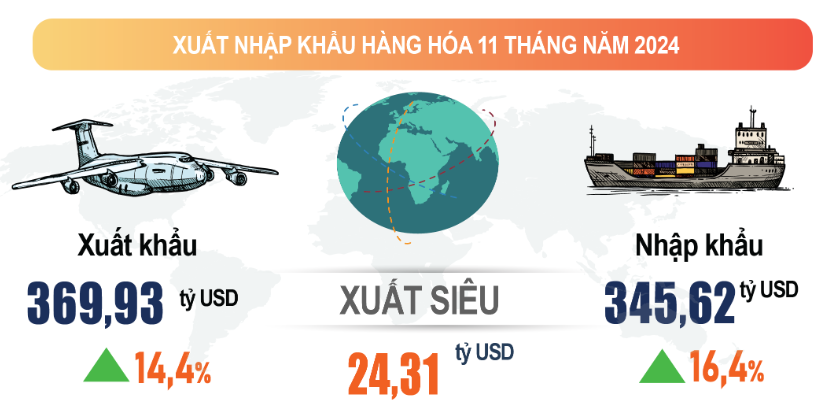
Notably, despite the faster growth rate of imports compared to exports, the trade balance in the first eleven months of the year still recorded a surplus of US$24.31 billion. In the import structure, production materials accounted for 93.7%, while consumer goods made up 6.3%. The higher import growth indicates that enterprises are actively importing to prepare for production and export plans in December 2024 and the first months of 2025.
In the first eleven months of 2024, 36 export commodity groups earned more than US$1 billion, making up 94.1% of the total export turnover (seven groups earned over US$10 billion, accounting for 66.5%). Meanwhile, 44 groups of import commodities were valued at over US$1 billion, representing 92.6% of the total import turnover (five groups were valued at over US$10 billion, accounting for 51.4%).
Many commodities have reached their targets ahead of schedule, with import and export turnovers in the first eleven months surpassing the figures for the whole of 2023. Notably, all major agricultural products have exceeded their 2023 export values: Seafood by 2.2%; vegetables and fruits by 18.2%; rice by 13.4%; coffee by 16.3%; cashew nuts by 9.2%; and tea by 12.9%.
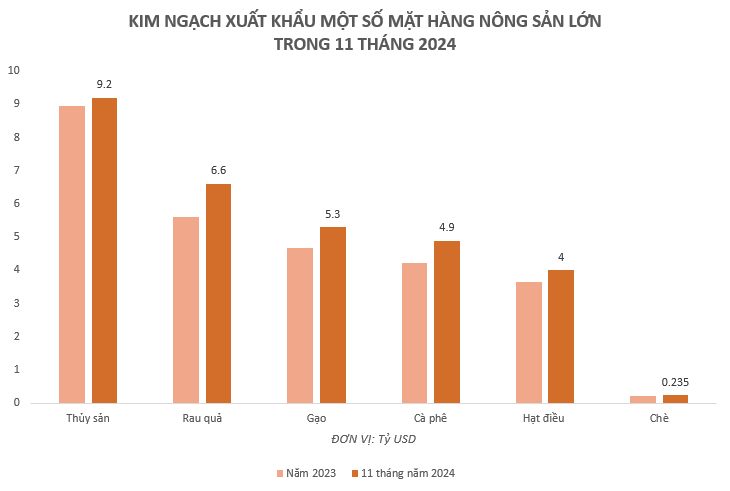
As of November 2024, all major agricultural products have exceeded their 2023 export values. Source: General Statistics Office
Additionally, several other commodities have also outperformed their 2023 export values: Electronics, computers, and components by 13.8%; textiles and garments by 1%; footwear by 2.6%; wood and wooden products by 9.1%; plastic products by 17.2%; non-wooden furniture by 19.1%; chemicals by 5.3%; and plastic raw materials by 13.1%.
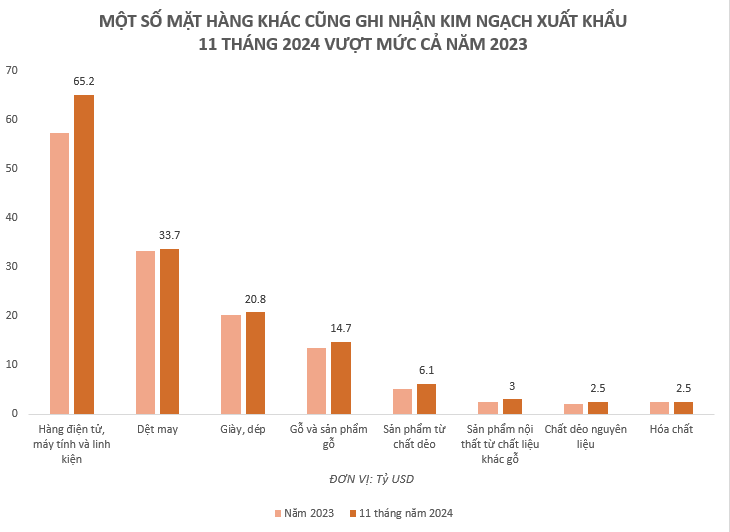
On the import side, several commodities have also surpassed their 2023 values: Electronics, computers, and components by 11.1%; machinery, equipment, tools, and other spare parts by 6.3%; fabric by 4.3%; iron and steel by 10.3%; plastics by 8.7%; mobile phones and components by 7.8%; plastic products by 6.8%; crude oil by 5.7%; raw materials, accessories, and spare parts for textiles, garments, and footwear by 8.3%; iron and steel products by 10.1%; pharmaceuticals by 12.8%; and fruits and vegetables by 8.2%.
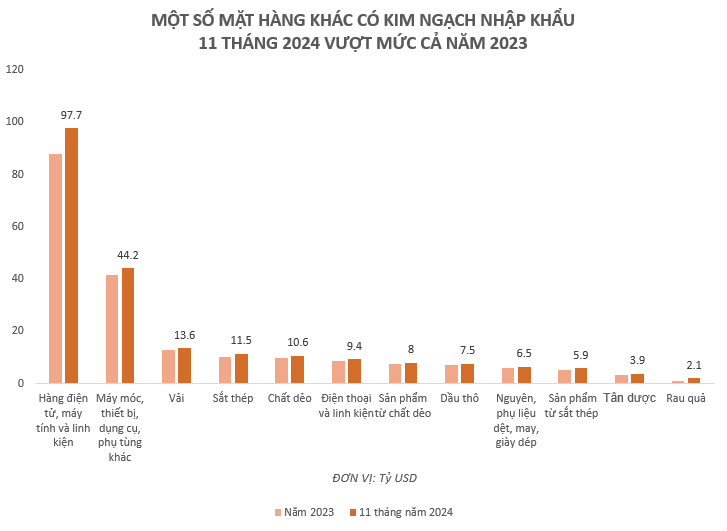
Other commodities that have also exceeded their 2023 values include fertilizers, rubber, wooden products, paper, fibers, products of common metals, household electrical appliances and components, electrical wires and cables.
The General Statistics Office forecasts that exports in the last month of 2024 will face challenges and risks from objective factors. However, Vietnam’s import and export activities are striving to reach their goals while aiming for new records.
As one of the main drivers of economic growth, the total import and export turnover for the year is expected to reach a new record of nearly US$800 billion, a 15% increase compared to the previous year and 2.5 times the assigned plan. The trade balance will record the ninth consecutive year of surplus, with a high value of nearly US$25 billion.
Among the import and export commodities this year, electronics, computers, and components stand out, with a total import and export turnover of US$163 billion. Of this, the import turnover in the first eleven months reached US$97.7 billion.
According to the General Statistics Office, this will be the first commodity of Vietnam to reach an import and export turnover of over US$100 billion. The trade deficit in this sector is also significant, at US$32.5 billion in the first eleven months of 2024. Mobile phones and components are the leading export surplus commodity, with a surplus of US$41 billion.
Another noteworthy aspect of the first eleven months is that the total export turnover has surpassed the export turnover of 2023 (US$354.72 billion) and is only slightly below the record level of 2022 by US$2 billion (the export turnover in 2022 was US$371.72 billion). At this point, it can be affirmed that the export turnover in 2024 will achieve a new record, surpassing US$400 billion.
“It took Vietnam’s economy many years to reach the US$100 billion export milestone in 2012, followed by another five years to surpass US$200 billion in 2017 and four years to exceed US$300 billion in 2021. Subsequently, in just three years, our export turnover has increased by another US$100 billion, reaching the US$400 billion mark. This can be considered a remarkable achievement in the country’s efforts to develop international trade,” stated the report by the General Statistics Office.
Unveiling Vietnam’s First Trade Commodity to Surpass the 100-Billion-USD Milestone in 2024
With the government’s synchronized policies to remove difficulties, support domestic production, promote trade, and expand export markets, Vietnam’s import and export activities have achieved positive results, maintaining a high growth rate and being one of the bright spots of the economy in 2024.
Enhancing Vietnam – China Relations: Fostering Trade and Collaboration
The Vietnam-China International Trade and Tourism Fair (Lang Son 2024) serves as a pivotal “bridge” for businesses from both nations to forge stronger collaborations and bolster trade. This event also plays a significant role in enhancing the cooperative and friendly relations between Lang Son and Guangxi, and more broadly, between Vietnam and China, across various domains, including commerce, tourism, and cultural exchanges.
“The Export Powerhouse of Dong Nai: Surpassing $13.27 Billion in Exports and Leading Vietnam’s Trade Surplus”
As of July 2024, Dong Nai’s export turnover for the year is estimated at $13.2756 billion, a notable 8.05% increase compared to the same period last year. Conversely, import turnover is estimated at $9.5263 billion, reflecting a 6.63% rise. With these impressive figures, Dong Nai boasts a trade surplus of $3.7493 billion.

























